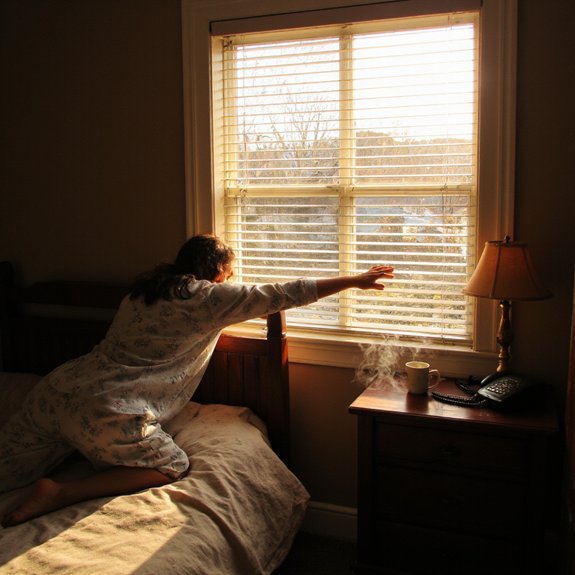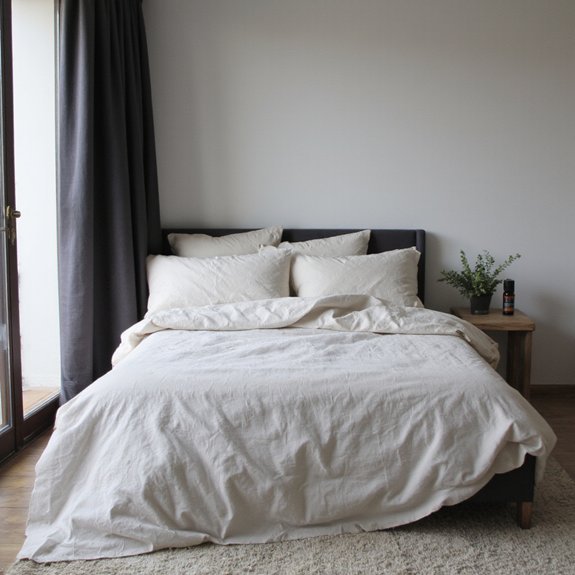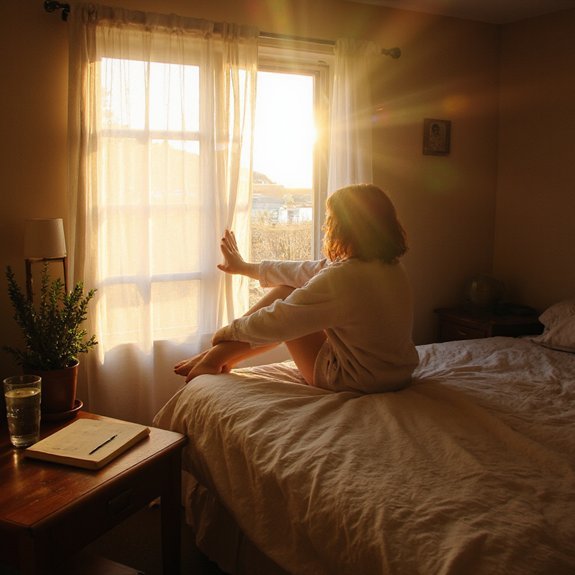You can improve sleep naturally by aligning behavior with your circadian rhythm and optimizing your bedroom and routines. Start with a fixed sleep-wake schedule, morning light exposure, limited evening blue light and caffeine, regular earlier exercise, and brief wind-down techniques. These changes yield measurable benefits. I’ll explain how to personalize them for your chronotype and when to take into account medical assessment.
Key Takeaways
- Keep consistent bed and wake times aligned with your chronotype, varying no more than 30–60 minutes.
- Optimize bedroom: cool (15–19°C), dark, quiet, good mattress, and low-blue lighting before bed.
- Use a short nightly wind-down: paced breathing, progressive muscle relaxation, or guided mindfulness to reduce arousal.
- Time light, meals, and exercise: morning bright light, finish meals 2–3 hours before bed, and exercise earlier in the day.
- Track sleep with a diary or wearable and consult a clinician if insomnia persists beyond four weeks.
Understand Your Sleep Cycle and Chronotype

Although your sleep alternates through NREM and REM stages roughly every 90–110 minutes, your chronotype determines when you’re biologically primed for sleep and wakefulness. You can assess chronotype with validated questionnaires or wrist actigraphy; clinicians use these to align schedules with circadian phase. Shifted timing raises fragmentation and metabolic risk; favor consistent timing within your chronotype window. Use objective measures: wearable sleep technology tracks sleep onset, duration, and circadian markers, while laboratory polysomnography clarifies pathology when needed. Integrate data with behavioral interventions—fixed wake time, light exposure management, timed exercise—to shift circadian phase gradually. If dreams or sleep-related behaviors disturb you, consider targeted evaluation; dream analysis can inform treatment of REM-related disturbances but isn’t diagnostic alone. For persistent insomnia, circadian rhythm disorders, or suspected sleep apnea, refer to a sleep specialist for evidence-based therapies such as CBT-I, chronotherapy, or CPAP. Monitor outcomes and iterate based on objective regular feedback.
Optimize Your Bedroom Environment

Now that you’ve aligned sleep timing with your circadian profile and behaviors, optimize the physical sleep environment to support consolidated sleep and circadian cues. Evaluate mattress quality: choose support and pressure relief matched to your biomechanics and replace if older than eight years or if sagging. Control room temperature; target 15–19°C (60–67°F) for most adults to facilitate thermoregulation. Configure lighting options that minimize blue wavelength exposure before bedtime and provide tunable, warm-spectrum fixtures for pre-sleep cues. Implement noise control using soundproofing, white-noise machines, or targeted masking to reduce transient arousals. Apply plant selection strategically: low-allergen, low-VOC species can modestly improve air quality and psychological calm without increasing night respiration. Prefer muted color schemes—cool, desaturated tones that reduce visual arousal and enhance perceived coolness. Test changes objectively: use actigraphy or sleep logs to quantify improvements and iterate environmental adjustments based on measured sleep consolidation and subjective sleep quality metrics.
Build a Consistent Sleep-Wake Routine

Because your circadian system responds to regular cues, keeping consistent wake and sleep times is one of the most effective, evidence-based ways to improve sleep consolidation and daytime function. You should set fixed rise and lights-out times across weekdays and weekends, varying no more than 30–60 minutes, to stabilize circadian phase and sleep architecture. Treat the sleep schedule as a parameter: track adherence, adjust gradually by 15–30 minutes if shifting, and prioritize morning light exposure to reinforce timing. Pair timing with a concise bedtime ritual that signals neural shift to sleep—low-stimulation activities of predictable duration rather than variable tasks. Use objective measures (sleep diary, wearable metrics) to monitor sleep latency, efficiency, and daytime alertness, iterate your schedule based on data. If insomnia persists beyond weeks despite consistent timing, seek a sleep specialist for assessment and time-based therapies such as chronotherapy or cognitive behavioral interventions tailored to your circadian profile.
Manage Stress and Effective Wind-Down Practices
Stable sleep timing helps set circadian phase, but physiological and cognitive arousal can still impair sleep onset and quality; managing stress and using targeted wind-down practices addresses those arousal mechanisms directly. You’ll reduce hyperarousal by adopting brief, repeatable routines that downregulate the sympathetic nervous system and quiet pre-sleep cognition. Prioritize interventions with empirical support and simple tech integration.
- 10–20 minutes of paced breathing and progressive muscle relaxation (relaxation exercises) to lower heart rate and somatic tension.
- Guided mindfulness techniques or brief imagery protocols to shift attention away from ruminative thoughts; use prerecorded prompts if you want scalable consistency.
- Structured cognitive reappraisal: jot a single worry list, schedule a next-day plan, then practice a 5-minute cognitive defusion exercise to terminate rehearsal.
Measure effects objectively with sleep diaries or consumer sleep trackers, iterate protocols, and consult a clinician if insomnia persists beyond four weeks. Adopt, test, refine.
Time Food, Light, and Exercise to Support Sleep
When you schedule meals, light exposure, and exercise to align with your circadian system, you strengthen sleep timing and improve sleep onset and architecture. You should eat earlier in the evening, use bright light in the morning, dim lights at night, and select exercise types that boost daytime alertness without late-night arousal. Consistent meal timing anchors peripheral clocks; avoid heavy late dinners. Morning outdoor light advances phase; evening light delays it. Prefer aerobic or resistance sessions earlier; reserve gentle mobility for evening. These strategies are supported by circadian and sleep physiology and can improve sleep efficiency and slow-wave sleep.
| Target | Recommendation |
|---|---|
| Morning light | 20–30 min outdoor |
| Meal timing | Finish main meal 2–3 h before bed |
| Exercise types | Aerobic/resistance AM–late afternoon |
| Evening light | Low lux, warm spectrum |
Integrate changes gradually and monitor sleep metrics. Consider wearable-tracked sleep and light dosimetry to quantify effects over weeks for personalized optimization. Strategies.
